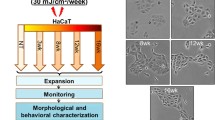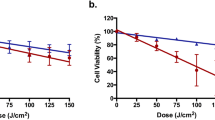Abstract
The human skin equivalent (HSE) provides a convenient model for studying the dermatological effects of exposure to ultraviolet (UV) radiation. HSEs, constructed by overlaying a collagen-fibroblast matrix with epidermal cells, were maintained submerged for 1 week after the addition of epidermal cells and then raised to the air-liquid interface for an additional 3 weeks. HSEs were exposed to sublethal doses of UV radiation ranging from 0 to 500 J/m2, incubated up to 48 h in medium containing 3H-thymidine and fixed for ultrastructural and autoradiographic analysis. Exposure to radiation doses greater than 50 J/m2 led to vacuolation of the cornified envelopes and enlargement of intercellular spaces. These doses also led to the formation of dense cytoplasmic bodies, and separation and vesiculation of the nuclear envelope in the basal cells. DNA synthesis in the basal cells was analyzed autoradiographically. Maximal numbers of labeled basal cells were observed 24 h after exposure to UV radiation at 50 J/m2. Although the proportions of labeled cells varied among different epidermal donors, the maximal responses and time-course of 3H-thymidine incorporation remained consistent, supporting the usefulness of the HSE in studying the effects of UV irradiation on human skin.
Similar content being viewed by others
References
Asselineau D, Bernhard B, Bailly C, Darmon M, Pruniéras M (1986) Human epidermis reconstructed by culture: is it “normal”? J Invest Dermatol 86: 181–186
Bell E, Ehrlich HP, Sher S, Merrill C, Sarber R, Hull B, Nakatsuji T, Church D, Buttle DJ (1981) Development and use of a living skin equivalent. Plast Reconstr Surg 67: 386–392
Bell E, Sher S, Hull B, Merrill C, Rosen S, Chamson A, Asselineau D, Dubertret L, Coulomb B, Lapiere C, Nusgens B, Neveux Y (1983) The reconstruction of living skin. J Invest Dermatol 81: 2s-10s
Brash DE, Rudolph JA, Simon JA, et al (1991) A role for sunlight in skin cancer: UV-induced p53 mutations in squamous cell carcinoma. Proc Natl Acad Sci USA 88: 10124–10128
Cleaver JE (1968) Defective repair replication of DNA in xeroderma pigmentosum. Nature 218: 652–656
Cleaver JE (1970) DNA damage and repair in light-sensitive human skin disease. J Invest Dermatol 54: 181
Cleaver JE, Kraemer KH (1989) Xeroderma pigmentosum. In: Scriver CR (ed) The metabolic basis of inherited disease. McGraw-Hill, New York
Daniels F, Brophy D, Lobitz W C (1961) Histochemical responses of human skin following ultraviolet irradiation. J Invest Dermatol 37: 351–357
Eisinger M, Lee J, Lefton JM, Darzynkiewicz Z, Chiao JW, Harven E de (1979) Human epidermal cell cultures: growth and differentiation in the absence of dermal components or medium supplements. Proc Natl Acad Sci USA 76: 5340–5344
Epstein JH (1983) Photocarcinogenesis, skin cancer, and aging. J Am Acad Dermatol 9: 487
Green AES, Findley GB, Klenk KF, Wilson WM, Mo T (1976) The ultraviolet dose dependence of nonmelanoma skin cancer incidence. Photochem Photobiol 24: 353–362
Green H, Fuchs E, Watt F (1982) Differentiated structural components of the keratinocyte. Cold Spring Harb Symp Quant Biol 49: 293–301
Hanawalt PC, Sarasin A (1986) Cancer-prone hereditary diseases with DNA processing abnormalities. Trends Genet 2: 188–192
Haringer MD, Hull BE (1992) Cornification and basement membrane formation in a bilayered human skin equivalent maintained at an air-liquid interface. J Burn Care Rehab 13: 187–193
Hull BE, Finley RK, Miller SF (1990) Coverage of full-thickness burns with bilayered skin equivalents. a preliminary clinical trial. Surgery 107: 496–502
Johnson BE Daniels F (1969) Lysosomes and the reactions of skin to ultraviolet radiation. J. Invest Dermatol 53: 85–94
Kantor GJ, Barsalou LS, Hanawalt PC (1990) Selective repair of specific chromatin domains in UV-irradiated cells from xeroderma pigmentosum complementation group C. Mutat Res 235: 171–180
Kerr JF, Wyllie AH, Currie AR (1972) Apoptosis: a basic biological phenomenon with wide ranging implications in tissue kinetics. Br J Cancer 26: 239–257
Kraemer KH, Lee MM, Scotto J (1987) Xeroderma pigmentosum: Cutaneous, ocular, and neurologic abnormalities in 830 published cases. Arch Dermatol 123: 241–250
Nelson D, Gay RJ (1993) Effects of UV irradiation on a living skin equivalent. Photochem Phorobiol 57: 830–837
Nix TE (1967) Ultraviolet-induced changes in epidermis. In: Zelickson A (ed) Ultrastructure of normal and abnormal skin. Lea and Febiger, Philadelphia, pp 304–319
Nix TE, Nordquist RE, Scott JR, Everett MA (1965) Ultrastructural changes induced by ultraviolet light in human epidermis: basal and spinous layers. J Invest Dermatol 45: 52–64
Punnonen K, Yuspa SH (1992) Ultraviolet light irradiation increases cellular diacylglycerol and induces translocation of diacylglycerol kinase in murine keratinocytes. J Invest Dermatol 99: 221–226
Schwartz T, Luger TA (1989) Effect of UV irradiation on epidermal cytokine production. J Photochem Photobiol [B] 4: 1–13
Scotto J, Kopf AW, Urbach F (1974) Nonmelanoma skin cancer in four areas of the U.S. Cancer 34: 1331–1338
Strickland PT (1991) Solar radiation induced skin cancer and DNA photoproducts in man. In: Woodhead AD (ed) DNA damage and repair in human tissue. (Brookhaven Symposium in Biology No. 36) Plenum, New York
Venema J, van Hoffen A, Natarajan AT, van Zeeland AA, Mullenders LHF (1990) The residual repair capacity of xeroderma pigmentosum complementation group C fibroblasts is highly specific for transcriptionally active DNA. Nucleic Acids Res 18: 443–448
Wier K, Fukuyams K, Epstein WL (1971) Nuclear changes during light-induced depression of ribonucleic acid protein synthesis in human epidermis. Lab Invest 25: 451–456
Wilgram GF, Kidd RL, Krawczyk WS, Cole PL (1970) Sunburn effect on keratinosomes. A report with special note on ultraviolet-induced dyskeratosis. Arch Dermatol 101: 505–519
Zamansky GB, Chou I (1987) Environmental wavelengths of ultraviolet light induce cytoskeletal damage. J Invest Dermatol 89: 603–606
Author information
Authors and Affiliations
Rights and permissions
About this article
Cite this article
Harriger, M.D., Hull, B.E. Characterization of ultraviolet radiation-induced damage to keratinocytes in a skin equivalent in vitro. Arch Dermatol Res 286, 319–324 (1994). https://doi.org/10.1007/BF00402222
Received:
Issue Date:
DOI: https://doi.org/10.1007/BF00402222




